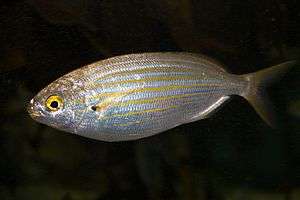Salema porgy
Sarpa salpa, known commonly as the dreamfish, salema, salema porgy, cow bream or goldline, is a species of sea bream, recognisable by the golden stripes that run down the length of its body, and which can cause Ichthyoallyeinotoxism when eaten.[2] It is found in the East Atlantic, where it ranges from the Bay of Biscay to South Africa, as well as in the Mediterranean.[3] It has occasionally been found as far north as Great Britain.[2] It is generally common and found from near the surface to a depth of 70 m (230 ft).[1] Males are typically 15 to 30 cm (6–12 in) in length, while females are usually 31 to 45 cm (12–18 in).[4] The maximum size is 51 cm (20 in).[3]
| Salema porgy | |
|---|---|
 | |
| Scientific classification | |
| Kingdom: | |
| Phylum: | |
| Class: | |
| Order: | |
| Family: | |
| Genus: | Sarpa Bonaparte, 1831 |
| Species: | S. salpa |
| Binomial name | |
| Sarpa salpa | |
Sarpa salpa became widely known for its ichthyoallyeinotoxic effects following widely publicized articles in 2006, when two men ingested it at a Mediterranean restaurant and began to experience many auditory and visual hallucinogenic effects.[5] These hallucinations, described as frightening, were reported to have occurred two hours after the fish was ingested and had a total duration of 36 hours.[6] The fish, and especially its viscera, have been assessed as potentially unsafe by a study conducted on Mediterranean specimens.[7] It is believed that the fish ingests a particular algae or phytoplankton which renders it Ichthyoallyeinotoxic. The effects described are similar to those of indole tryptamine psychedelics.[5]
References
- Bizsel, C.; Kara, M.H.; Pollard, D.; Yokes, B.; Goren, M. & Francour, P. (15 April 2015). "Sarpa salpa". IUCN Red List of Threatened Species. 2011. Check date values in:
|year= / |date= mismatch(help)CS1 maint: ref=harv (link) - Fish that triggers hallucinations found off British coast. The Daily Telegraph May 13, 2009. Accessed May 27, 2013.
- Froese, Rainer and Pauly, Daniel, eds. (2015). "Sarpa salpa" in FishBase. April 2015 version.
- Jadot, C.; Donnay, A.; Acolas, M.; Cornet, Y.; Begoutanras, M. (2006). "Activity patterns, home-range size, and habitat utilization of Sarpa salpa (Teleostei: Sparidae) in the Mediterranean Sea". ICES Journal of Marine Science. 63 (1): 128–139. doi:10.1016/j.icesjms.2005.06.010. Retrieved 12 February 2015.
- Pommier, De Haro (October 2006). "Hallucinatory Fish Poisoning (Ichthyoallyeinotoxism): Two Case Reports From the Western Mediterranean and Literature Review". Clinical Toxicology 2006, Vol. 44, No. 2 : Pages 187. doi:10.1080/15563650500514590.
- "This Hallucinogenic Fish Was Used By The Romans As A Recreational Drug", accessed 17 October 2017, https://truththeory.com/2017/02/26/hallucinogenic-fish-used-romans-recreational-drug/
- Khaled Bellassoued; Jos Van Pelt & Abdelfattah Elfeki (22 Sep 2014). "Neurotoxicity in rats induced by the poisonous dreamfish (Sarpa salpa)". Pharmaceutical Biology 2015, Vol. 53, No. 11 : Pages 286-295. doi:10.3109/13880209.2014.916311.
Liver and especially the visceral part of S. salpa presented toxicity, which clearly indicates the danger of using this fish as food.
| Wikimedia Commons has media related to Sarpa salpa. |
External links
- Photos of Salema porgy on Sealife Collection
